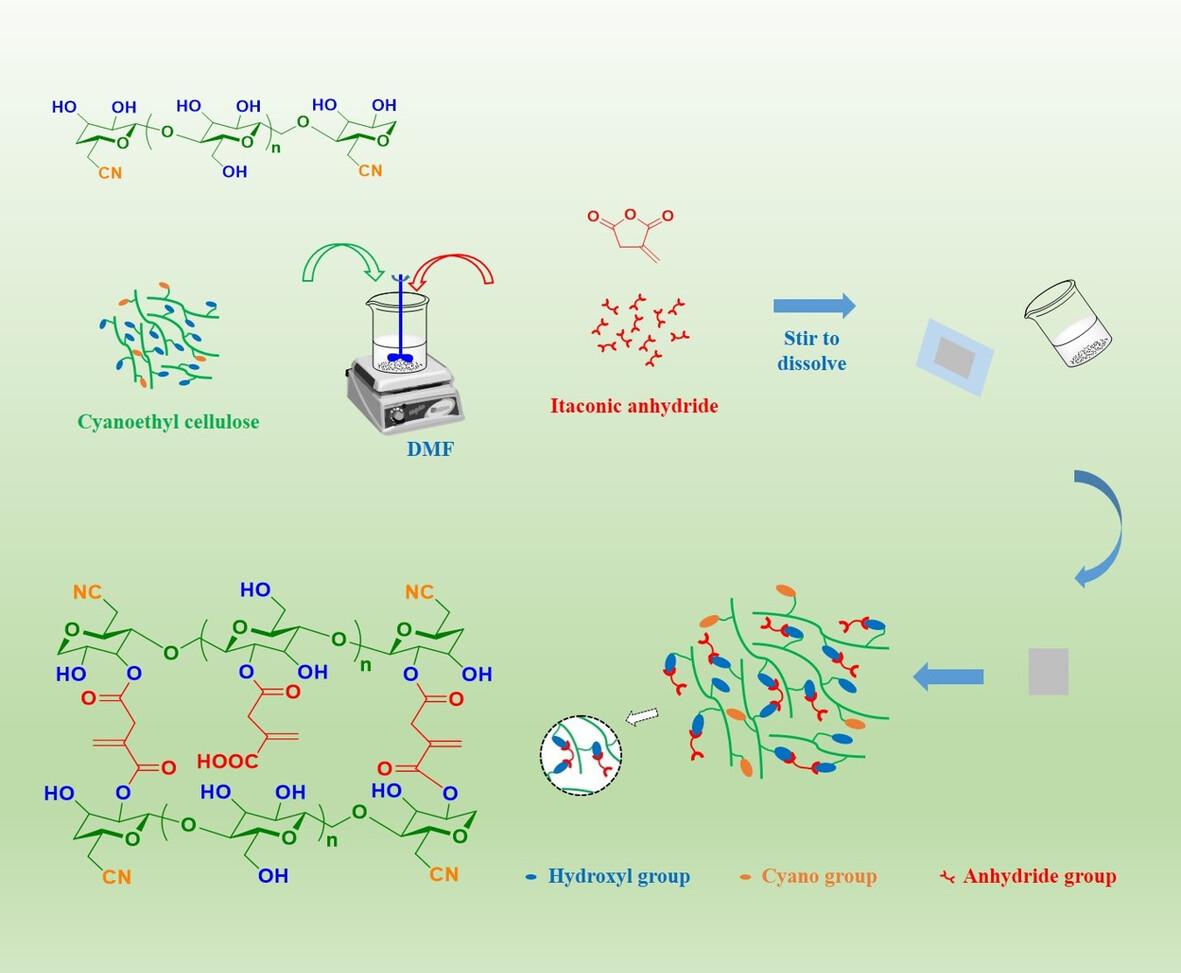求助PDF
{"title":"具有交联结构的衣康酸酐功能化氰乙基纤维素可改善介电性能","authors":"Sen Cheng, Xinyu Wang, Rui Yang, Jiabao Wang, Chunhua Lu, Kai Guo, Ning Zhu, Xin Hu","doi":"10.1002/pi.6680","DOIUrl":null,"url":null,"abstract":"<p>As a type of cellulose ether, cyanoethyl cellulose (CEC) is considered to be a promising candidate for polymer dielectrics due to its sustainable nature and high dielectric constant induced by the cyano groups. However, the relatively high conduction loss of CEC arising from the charge motion across the polymer degrades its dielectric properties. In this work, we designed and synthesized an all-organic polymer composite of CEC/itaconic anhydride (ITA) to improve dielectric properties. The CEC matrix was graft functionalized by ITA via an esterification reaction between the anhydride groups of ITA and hydroxyl groups of CEC. Meanwhile, crosslinking structure was also established in the composite by the generation of diester. Significantly improved dielectric constant (<i>ε</i><sub>r</sub>), elevated breakdown strength (<i>E</i><sub>b</sub>), restrained dielectric loss (tan <i>δ</i>) and decreased conductivity (<i>σ</i>) were observed in the composites compared with unmodified CEC. The <i>ε</i><sub>r</sub> increased from 17 for pure CEC to 32 for CEC/ITA at 1 kHz, and <i>E</i><sub>b</sub> also soared from 145 MV m<sup>−1</sup> for CEC to 226 MV m<sup>−1</sup> for the composite. The tan <i>δ</i> reduced from 0.24 for pure CEC to about 0.05 for the composite at 100 Hz. This should be attributed to the molecule trapping centers arising from the high electron affinity ITA and the formation of crosslinked networks as well as hydrogen bonding, which impeded the electric conduction. It also provided additional advantages of better dielectric properties for the CEC/ITA composites than pure CEC at high temperatures, which may offer inspiration for the design and preparation of bio-based dielectrics for high temperatures. © 2024 Society of Chemical Industry.</p>","PeriodicalId":20404,"journal":{"name":"Polymer International","volume":"73 12","pages":"1022-1029"},"PeriodicalIF":2.9000,"publicationDate":"2024-07-15","publicationTypes":"Journal Article","fieldsOfStudy":null,"isOpenAccess":false,"openAccessPdf":"","citationCount":"0","resultStr":"{\"title\":\"Itaconic anhydride functionalized cyanoethyl cellulose with crosslinked structure enabled improved dielectric properties\",\"authors\":\"Sen Cheng, Xinyu Wang, Rui Yang, Jiabao Wang, Chunhua Lu, Kai Guo, Ning Zhu, Xin Hu\",\"doi\":\"10.1002/pi.6680\",\"DOIUrl\":null,\"url\":null,\"abstract\":\"<p>As a type of cellulose ether, cyanoethyl cellulose (CEC) is considered to be a promising candidate for polymer dielectrics due to its sustainable nature and high dielectric constant induced by the cyano groups. However, the relatively high conduction loss of CEC arising from the charge motion across the polymer degrades its dielectric properties. In this work, we designed and synthesized an all-organic polymer composite of CEC/itaconic anhydride (ITA) to improve dielectric properties. The CEC matrix was graft functionalized by ITA via an esterification reaction between the anhydride groups of ITA and hydroxyl groups of CEC. Meanwhile, crosslinking structure was also established in the composite by the generation of diester. Significantly improved dielectric constant (<i>ε</i><sub>r</sub>), elevated breakdown strength (<i>E</i><sub>b</sub>), restrained dielectric loss (tan <i>δ</i>) and decreased conductivity (<i>σ</i>) were observed in the composites compared with unmodified CEC. The <i>ε</i><sub>r</sub> increased from 17 for pure CEC to 32 for CEC/ITA at 1 kHz, and <i>E</i><sub>b</sub> also soared from 145 MV m<sup>−1</sup> for CEC to 226 MV m<sup>−1</sup> for the composite. The tan <i>δ</i> reduced from 0.24 for pure CEC to about 0.05 for the composite at 100 Hz. This should be attributed to the molecule trapping centers arising from the high electron affinity ITA and the formation of crosslinked networks as well as hydrogen bonding, which impeded the electric conduction. It also provided additional advantages of better dielectric properties for the CEC/ITA composites than pure CEC at high temperatures, which may offer inspiration for the design and preparation of bio-based dielectrics for high temperatures. © 2024 Society of Chemical Industry.</p>\",\"PeriodicalId\":20404,\"journal\":{\"name\":\"Polymer International\",\"volume\":\"73 12\",\"pages\":\"1022-1029\"},\"PeriodicalIF\":2.9000,\"publicationDate\":\"2024-07-15\",\"publicationTypes\":\"Journal Article\",\"fieldsOfStudy\":null,\"isOpenAccess\":false,\"openAccessPdf\":\"\",\"citationCount\":\"0\",\"resultStr\":null,\"platform\":\"Semanticscholar\",\"paperid\":null,\"PeriodicalName\":\"Polymer International\",\"FirstCategoryId\":\"92\",\"ListUrlMain\":\"https://onlinelibrary.wiley.com/doi/10.1002/pi.6680\",\"RegionNum\":4,\"RegionCategory\":\"化学\",\"ArticlePicture\":[],\"TitleCN\":null,\"AbstractTextCN\":null,\"PMCID\":null,\"EPubDate\":\"\",\"PubModel\":\"\",\"JCR\":\"Q2\",\"JCRName\":\"POLYMER SCIENCE\",\"Score\":null,\"Total\":0}","platform":"Semanticscholar","paperid":null,"PeriodicalName":"Polymer International","FirstCategoryId":"92","ListUrlMain":"https://onlinelibrary.wiley.com/doi/10.1002/pi.6680","RegionNum":4,"RegionCategory":"化学","ArticlePicture":[],"TitleCN":null,"AbstractTextCN":null,"PMCID":null,"EPubDate":"","PubModel":"","JCR":"Q2","JCRName":"POLYMER SCIENCE","Score":null,"Total":0}
引用次数: 0
引用
批量引用



